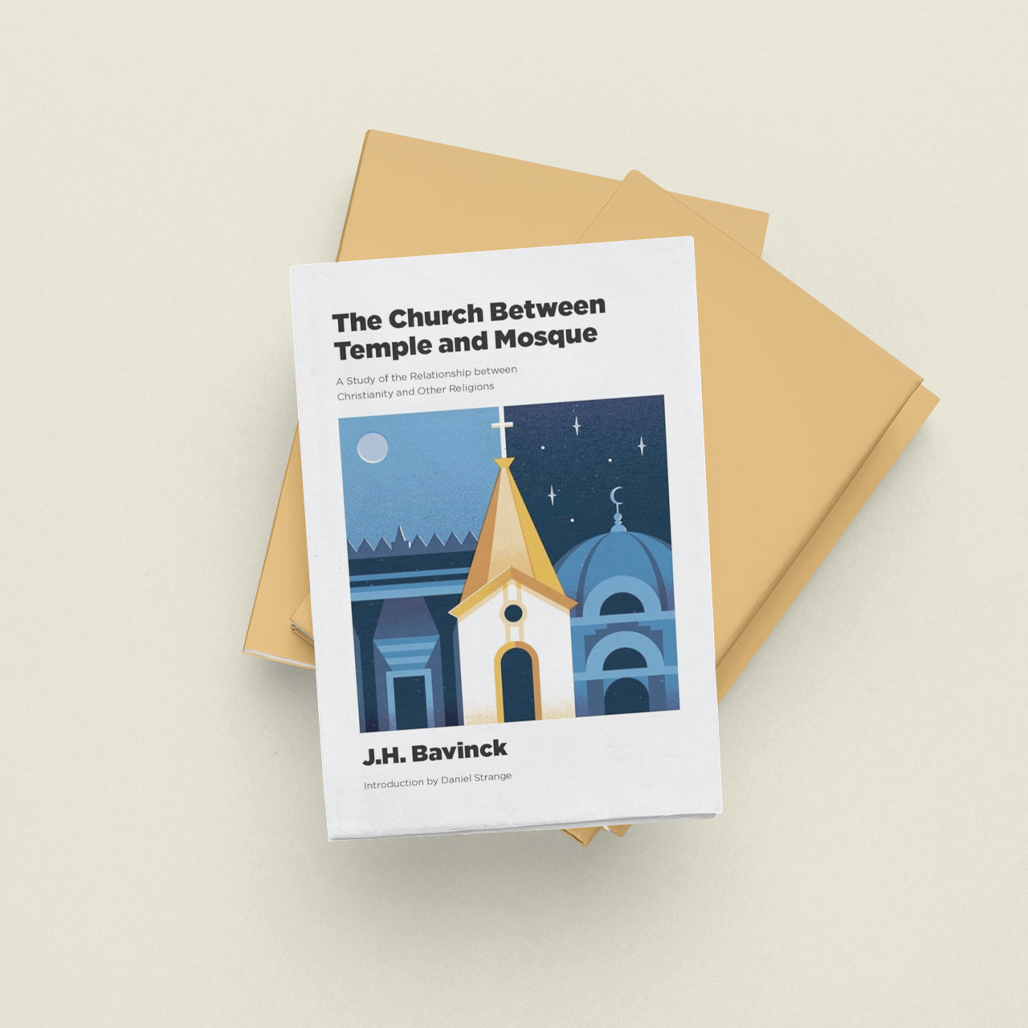Book
The Church Between Temple and Mosque: A Study of the Relationship between Christianity and Other Religions
A study of the Relationship between Christianity and Other Religions
The Other Bavinck
When you search the name ‘Bavinck’, the results send you to Reformed theologian Herman Bavinck (1854–1921), perhaps best recognized in the English-speaking world for his four volume Reformed Dogmatics[1]. It comes as a surprise to discover that there is another Bavinck—less prolific, certainly less well-known, but perhaps just as helpful in his respective field.
Johan Herman (J.H.) Bavinck was born in 1895 into a ministry-focused family. Upon the completion of doctoral studies in the psychology of religion he served as an ordained minister as well as theological instructor in Indonesia from 1919–1938. Upon his return to the Netherlands, he served as a professor in various university posts until his death in 1964. During this time he published his most well-known works: Religious Consciousness and the Christian Faith (1949),[2] An Introduction to the Science of Missions (1954),[3] and The Church Between Temple and Mosque (published posthumously in 1966) (xv).[4] In his introduction to the present volume,[5] Daniel Strange notes the present resurgence of Bavinck studies and laments the fact that the younger Bavinck has been largely forgotten (xiv). Yet Bavinck was a significant influence on recent figures within the Reformed tradition (and particularly at Westminster Theological Seminary) such as Ed Clowney, Harvie M. Conn, and the late Tim Keller. Indeed, the fact that this volume is published by Westminster Seminary Press serves as a testament to J.H. Bavinck’s influence on leading lights in the history of that institution. Readers interested in further J.H. Bavinck studies will be pleased to note that a reader of Bavinck’s works edited by John Bolt is available from Eerdmans.[6] Along with the republication of the present volume, this work indicates a rising interest in a premier Dutch Calvinist missiologist of the twentieth century.
Christianity Against the Religions
Bavinck aims to demonstrate that the answer humans so desperately need is found in Christ, who reveals the Father and provides the path of redemption, thus providing answers to the most fundamental questions of human existence.
Bavinck’s aim in this book is two-fold. First, he aims to show that every religion in the world is animated by questions that assault every person. While humanity is by nature religious, religion is not merely the outworking of an interior sense that can either be cultivated or suppressed (a very Kantian reading), rather, ‘religion by its nature is a response. . . . the human answer to divine, or at least allegedly divine, revelation’ (p. 12). The Creator everywhere confronts the creature, which requires the creature to respond. The ‘deepest mystery’ of the history of humanity ‘is the story of God’s concern with man and man’s response to God’s revelation’ (p. 13). Every person responds to this revelation in some fashion. Culture too, Bavinck argues, is a collective expression of this response. Despite the widely varying cultures and subcultures around the world, every culture recognizes that humanity faces deep, unrelenting questions to which it must provide an answer. Second, Bavinck aims to demonstrate that the answer humans so desperately need is found in Christ, who reveals the Father and provides the path of redemption, thus providing answers to the most fundamental questions of human existence.
He approaches his task by outlining five ‘magnetic points’ which no one can evade. These are 1) the sense of cosmic relationship, 2) the religious norm, 3) the riddle of his existence, 4) a craving for salvation,and 5) the question of the reality behind reality (pp. 26–27). In short, humanity recognizes that it forms a part of the material universe, is bound to it in some way, yet is also over it. Second, there is a vague sense of some moral order to which they ought to adhere, a law written on individual hearts, and a conscience that excuses or condemns (Rom 2:15). Third, though recognizing his active role in the world, man also recognizes that ‘he is the victim of that indefinable something which he is inclined to call his fate or destiny’ (p. 27), over which he has no power. Fourth, people recognize their own brokenness and that of the world and long for it all to be set right. They anticipate and desire a better world. Finally, try as they might, people cannot escape the sense that a veil separates them from a world of cosmic forces and that over them a Supreme Being, to which they bear some relation,reigns. These points are not innate ideas but questions which bear down on people everywhere. How they live, individually and as collective cultures, reveal a response, indeed are an embodied answer to these questions (p. 28).
In Part 1, Bavinck traces these five questions through various religions. He typically begins the chapter with a description of the question and the reason it arises, then shows how it was answered by primal religions before walking through the responses of one or more of the major non-Christian religions (Hinduism, Buddhism, Islam, etc.). The purpose behind this schema is not to provide a comparative study of the religions, but to show that every religion in every age provides an answer to the five ‘magnetic points’.
Located between temple and mosque, the church cannot withdraw. The religions of the world are on its doorstep, offering their own answers to the deepest questions of life.
In Part 2, Bavinck retraces the five points, but this time shows how God in Christ answers them all. Taking Romans 1 as his starting point, Bavinck explains that in general revelation God confronts humankind everywhere. While humanity suppresses and rejects this revelation, we cannot escape from providing answers to the questions that revelation asks, and as a result we fabricate idols and replace the revelation of God with myths (p. 118). At the heart of each point in this section is what humanity has rejected and that it needs intervention. Created, yet severed from the Creator, the questions humanity constantly asks can only be answered by the one who transcends and can transform humankind by his grace in Christ. In this, Bavinck demonstrates the fundamental difference between how Christianity answers the five points as compared to every other religion. This is the message that the church declares to the world. Located between temple and mosque, the church cannot withdraw. The religions of the world are on its doorstep, offering their own answers to the deepest questions of life.

The Church’s Task Between Temple and Mosque
Bavinck’s perceptive study provides a helpful grid through which Christians can analyze the faith of their neighbors by mapping answers to deep questions onto religious beliefs, sacred texts, and activities. Even more so, the ‘magnetic points’ indicate the kinds of probing questions that can lead to new appreciation for and understanding of the positions of neighbors as well as open avenues to proclaim the gospel with care and wisdom.
Bavinck’s analysis of humanity’s religious posture will serve readers in several ways. It first provides opportunities for introspection. Individual Christians and churches would do well to review their own responses to Bavinck’s ‘magnetic points’ and ask, ‘Are we guilty of syncretism?’ The perennial temptation to repackage beliefs in anthropocentric forms is not confined to frontier mission fields, rather it is present in every church in every country and age. The church is made up of people more naturally prone to building individual towers of Babel than bowing in reverent worship, and thus suffers the threat of rewriting beliefs to conform to the pressures of a given age. Her task, therefore, is to submit again to God who reveals himself in saving his people in Christ and who provides the definitive interpretation of that event in his word. Second, Bavinck’s study invites engagement with world religions. The religions of the world are, for many, right next door. Not only is the church between temple and mosque, but the Christian lives among Muslims, Hindus, Buddhists, Jews, Daoists, atheists, agnostics, New Age pagans, and more. Each one shares basic questions to which they seek answers. Bavinck’s perceptive study provides a helpful grid through which Christians can analyze the faith of their neighbors by mapping answers to deep questions onto religious beliefs, sacred texts, and activities. Even more so, the ‘magnetic points’ indicate the kinds of probing questions that can lead to new appreciation for and understanding of the positions of neighbors as well as open avenues to proclaim the gospel with care and wisdom. He shows how the gospel subverts the assumptions of the religions and, in so doing, answers their deepest desires. Such engagement requires patience, careful listening, deep thinking, constant prayer, and humility—in short, love.
The Religious West
At several points within the book, Bavinck points out that those who put religion behind them merely trade one—more obvious— form, for another, subtler religious practice. His prescient remarks make clear that, were he alive today, he would stand adamantly by his basic argument that people, even if they identify as a religious ‘none’ or atheist, cannot avoid the moment-by-moment confrontation with the divine. The basic questions at the heart of Western culture today remain the same as those of first-century Rome.

Take Up and Read
Bavinck’s little volume is worthy of renewed interest and study. Bavinck offers an important lens through which Christians might better understand the variety of religious expression around them, assess the answers given, and offer the only solution that will truly satisfy. Take up, then, and read! Bavinck will prove a helpful and stimulating guide as he challenges you to engage your neighbors with the only answer to their deepest longings and wonderings: the message of God’s grace in the gospel of the risen Christ.
Endnotes
- H. Bavinck, Reformed Dogmatics. (Grand Rapids: Baker Academic, 2003–2008).
- J.H. Bavinck, Religious Consciousness and the Christian Faith. (1949).
- J.H. Bavinck, An Introduction to the Science of Missions. (Phillipsburg, NJ: P&R Publishing,1993).
- J.H. Bavinck, The Church Between Temple and Mosque. Grand Rapids, MI:Wm. B. Eerdmans Publishing Co.,1966).
- J. H. Bavinck, The Church Between Temple and Mosque: A Study of the Relationship between Christianity and Other Religions. (Glenside, PA: Westminster Seminary Press, 2023).
- J.Bolt, J.D.Bratt and P.J.Visser, The J.H. Bavinck Reader. (Grand Rapids, MI:Wm. B. Eerdmans Publishing Co., 2013).
Photos
Images by [rawpixel.com] from Freepik


